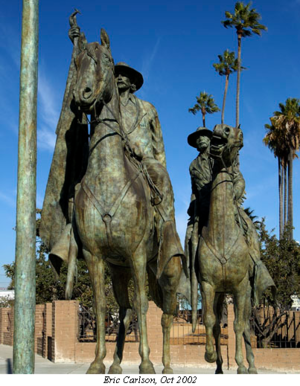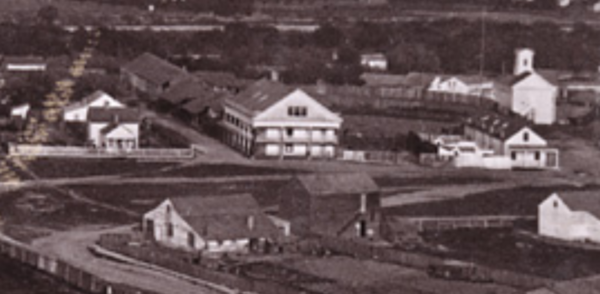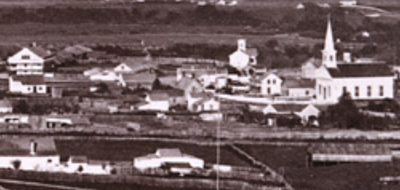History Pages: 16 - Uptown and Downtown
For a table of contents, see History pages.
The rapid transitions from mission to pueblo to county seat in only fifteen years from 1835 to 1850 meant many changes for Santa Cruz. New forms of just about every kind of human activity appeared during those years. The Mission had been, by necessity, self-reliant. The padres and their neophytes built and made and grew nearly everything they needed. When the Americans came, they took over some of the abandoned Mission operations, notably the grist mill and tannery. They also brought new ways and new talents. Merchants, manufacturers and other kinds of entrepreneurs appeared for the first time.
In 1846, an Irish-born, Canadian-raised American named Thomas Fallon came to Santa Cruz with Captain Fremont’s third expedition and stayed on to raise and command the group of twenty-two locals who marched off to capture the Pueblo of San Jose and join Fremont’s California Battalion when the Mexican-American War broke out later that year. Fallon returned from the war to San Jose, where he met Elihu Anthony. The two veterans came back over the hill to Santa Cruz in 1847, where Fallon took up his trade as a saddler while Anthony established his iron works. When the Gold rush began, it was Fallon who delivered Anthony’s iron picks to the gold fields.
With the money he made from sales of the picks and other goods, Fallon built a 2-story building on the Mission plaza, where the half-scale Mission replica is today. The structure housed Fallon’s residence, saddlery business and a hotel. Sometime in that period, he also found time to woo and wed Carmelita Castro Lodge, daughter of the grantees of Rancho Soquel.
Why, you may ask, don’t we find Fallon’s name on any signs in Santa Cruz? Well, because he left in 1853 and went back to San Jose. He built a very nice house downtown in 1855 that is preserved today as one of San Jose’s historic structures. In 1859, Fallon was elected to be the town’s tenth mayor and served a single one-year term. He even achieved that lofty symbol of approbation, a statue in the park (albeit an obscure park), after considerable controversy over the meaning of his legacy.
Meanwhile, the structure Fallon built on the plaza was sold and became the first county courthouse. Prior to that, Judge Blackburn’s court had presumably been located in the old juzgado which Blackburn had acquired in 1848 and converted into the Eagle Hotel. As any fan of western movies knows, every old-west hotel also had a saloon, so we have the interesting possibility that Judge Blackburn was also saloon-keeper Blackburn. Perhaps the name of a venerable bar across the street from today's courthouse (The Jury Room) is a tribute to those days of old. Incidentally, the residence next door to the Eagle Hotel belonged to one William Thompson. Readers of these History Pages in chronological order will remember Thompson as William Buckle, one of "The Sailors". No one knows why Buckle changed his name (as did his brother), so we can only speculate.
In the detail at right from the 1866 photo featured in a previous History Page ("The County"), the small two-story Fallon building is at left behind the white picket fence. To the right across what's now School Street is the former juzgado (where Holy Cross School is today). To the right of the juzgado is the Wm. Thompson house. In this ca.1866 photo, Fallon's building had become the first county hospital. The juzgado (and probably the Thompson house) had been sold to the Sisters of Charity, converted into the beginnings of their girls' boarding school complex. Two structures in this photo are still standing today. One is the long, low building extending along the street behind the juzgado. Now known as the Neary-Rodriguez Adobe, it's part of the Santa Cruz Mission State Historic Park. The other survivor is the white house at lower right, the 1850 Francisco Alzina house.
The Americans also brought new religious preferences to Santa Cruz. The First Methodist Church, which doubled as a schoolroom, was built in 1850 at the eastern corner of Mission and Green Streets. Elihu Anthony became its first pastor. The original structure was later moved to 123 Green Street (where it still stands as part of a private residence), to be replaced by the church building seen in this photograph. When Methodists move down to Church Street in 1890, the second building was sold to Holy Cross parish, who converted it (minus steeple) into Montgomery Hall. The Methodist churchyard was also the county’s first Protestant cemetery. At least some of the graves were later probably transferred to Evergreen cemetery, which opened in 1857. The detail (above) from another ca.1866 photo (both by Lawrence and Houseworth) shows the Methodist church at far right, and the juzgado at far left.
From construction dates of buildings, we can see that Santa Cruz development in the 1850s was split between the old Mission “upper plaza” area and the newer “lower plaza” down the Mission Street hill on the riverside flats. Anthony’s residence and iron works began the move to the flats and, by mid-decade, it was joined by many other structures, both commercial and residential. A “Main Street” was established (today’s Front Street from Mission to Cooper). At the south end of Main Street stood the mercantile store of two of the four Cooper brothers, John and William, who came to Santa Cruz from Gettysburg, PA in the early 1850s. The other two brothers went into the same business in Watsonville. Besides Cooper Street, Santa Cruz “old-timers” (pre-1989) remember the name from the old Cooper House. That building (built in 1894) was originally the third County courthouse (second on that site), built on land donated to the county by the Cooper and Eli Moore families.


